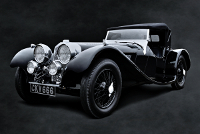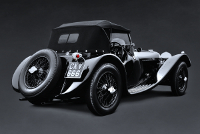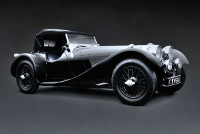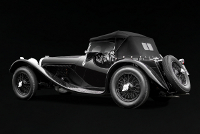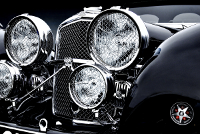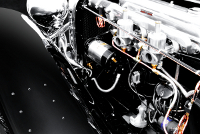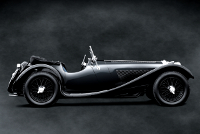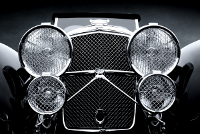Location:
Radnor Hunt Concours d'Elegance, 2011
Pebble Beach Concours d'Elegance, 2009
Owner: Robin & Alison Green | Norwich, Norfolk, United Kingdom
Prologue:
When we first encountered #39002 in California, the Greens had brought the car over from the UK. A year later in 2010, the car appeared at Villa d'Este in Italy. Then in 2011 we spotted #39002 here on the east coast after acquisition by the Rich family of Frackville, Pennsylvania, who opened their collection to the public prior to the pandemic. To my knowledge, the car remains in Pennsylvania, though shouldn't be confused with the Simeone Foundation's black SS 100, #39047, which is very similar.
Most of our survey hails from Pebble Beach under the Greens' stewardship, when the car found its way to the winners pen toward the end of the concours. Being such a globe-trotter, I'm happy to have run across this early Jaguar at the peak of its popularity.
- - - - - - - - - -
► Image Source: Nikon D200 (10.2 MP) | Image Source 7 by E, illustrated by the author.
References:
- JD Classics: The restoration shop discusses their time with #39002.
- SS Jaguar Data: The original description of #39002 from the 2010 Gooding & Company Pebble Beach auction.
- Gooding & Company: A brief entry on Lot 24 from their 2010 Pebble Beach auction.
- HistoricalStatistics.org: Conversion of the original cost in pounds sterling to U.S. dollars in 1938, basing the year on reported cost new in the first full SS 100 model year.
Of the few SS 100 cars produced, chassis #39002 is the second built. According to J.D. Classics, who performed the restoration, "chassis #1 was reportedly destroyed by fire not once but twice—once in the Blitz and again by fire." So this car proves to be the oldest surviving SS 100. Not only that, but Jaguar Heritage Trust confirmed that the car as presented—with registration CKV 666, chassis #39002, and motor #M501E—is exactly as completed by the factory on the 25th of November in 1937. The body, running gear, motor, transmission, and interior tub are all original to the car, meaning that no major components have been replaced in its lifetime. With this knowledge in hand, the SS was given a cost-no-object restoration with the intent to preserve what then became known as the finest example of its kind.
1937 is the earliest year for the new 3 ½ litre model, and the factory likely applied for the registration plate in order to test chassis #39002 prior to sale. The car itself was ordered by Captain John P. Black, the managing director of the Standard Motor Company, Ltd., a mechanical parts supplier for SS Cars. The black paint and navy blue hides are original to the car, the latter an extra-cost option. Captain Black did not take delivery of his car, however, and the SS 100 was sold on to a Mr. Bellhouse of New York, a turn of fate that would spare the car from the hardships of war and the unsurprising end of chassis number one. A string of owners in the United States kept the car in remarkable condition until it reached the hands of serious collectors both stateside and in Germany. Then in 2006, #39002 was acquired by Robin Green, who returned it to the United Kingdom where it received the tender care that few historic vehicles—even those of concours calibre—have ever seen.
Anecdotes that illustrate the obsessive quality of the restoration begin with the car's wiring loom. During research, the restoration team discovered that the SS 100 used a chevron pattern for the tracer color in the wire. Of course the base color, tracer color, and the pattern of electrical wire is something specific to many different manufacturers throughout history, and today even the most scrutineering wonks don't expect to see wire that's identical to the original. Nevertheless, the team commissioned 20 meters of each wire color combination needed to remake the loom. Most of this custom-braided wire is tucked away out of sight, wrapped up, or hidden inside conduits, but it's all period correct.
Similarly diligent in terms of the attention given to the car, the restoration team found that the original mesh screens covering the headlamps and grille were woven according to an imperial measurement with cross-hatches spaced at 12.7mm. Instead of using the 12 or 13mm square mesh available today, the team wove correct 12.7mm mesh. The team also spent hundreds of hours perfecting the louvres on the bonnet, and an excessive amount of time rebuilding the windshield wiper motor, armature, and linkage to ensure that it works faultlessly.
And would anyone drive this SS Jaguar in the rain after such a painstaking restoration? Well, no and yes. No in the sense that on its first event, a Jaguar Driver's Club meeting at Highclere Castle, owner Robin Green was understandably reluctant to drench the car in the day's thunderstorms, and only brought it out to drive once the rain cleared. But also yes in the sense that between events in England and Monterey, California, the car has seen a few grey days and wet roads, and has still performed flawlessly and received top honors.
The story of 39002's restoration, underscored in no small part by its remarkable state of completeness from birth, hefts a lot of temporal weight onto the car. This is the tipping point between being able to enjoy a wonderful vintage car, versus striving to preserve a piece of history. And we should note that it is not the car's tremendous monetary value that drives this distinction. Plenty of multi-million dollar cars are enjoyed heartily by those who own them because they are, at the heart, great cars. But leave cost aside and there's the question of period-correctness, as-new presentation, and originality. When a car has these qualities, managing the risk of damage is part of the owner's responsibility. That's simply the burden that comes with owning any artifact considered to be the very best of its kind, independent of however valuable those things may be.
Motor: 3,486 cc straight 6-cylinder, cast iron block and head | 82 mm x 110 mm | 7.2:1 compression
Valvetrain: SOHC, 2 valves per cylinder
Aspiration: twin SU carburetors
Power: 125 bhp @ 4,500 rpm
Drivetrain: 4-speed manual transmission with synchromesh on 2nd, 3rd, and 4th gears
Front Suspension: solid axle, semi-elliptic leafsprings with Luvax dampers
Rear Suspension: live axle, semi-elliptic leafsprings with Luvax dampers
Kerb Weight: 1,150 kg (2,535 lbs)
Wheelbase: 2,640 mm (103.9 inches)
0-60: 10.4 seconds
Top Speed: 163 km/h (101 mph)
Etymology:
'SS' stands for 'Swallow Sidecar,' which was changed to 'Jaguar' through the course of World War II due to Nazi connotations. However, the Jaguar mascot was debuted in 1936 and often applied to these early cars. This car's predecessor, the SS 90, was a 2 ½ litre car, whereas the SS 100 references its larger capacity 3 ½ litre motor. The title also includes the chassis number, 39002.
Figures:
Most sources site that 116 of the 3 ½ litre roadster were built between 1937 and 1940; this car, #39002, is the second in that line of production, and the oldest to survive.
Value:
Because #39002 is the oldest known survivor, and because it has survived in largely original condition, the car was given a cost-no-object restoration from 2006 through 2007. The obsessive accuracy of the restoration was later reflected in the car's sale price at the Gooding & Company Pebble Beach auction in 2010. Chassis #39002 claimed a record sale of $1,045,000, many times more than the average SS 100. The original cost of the car was £445, or about $2,172 dollars.
Big New Things: Context for the SS 100
The SS 100 is an ambitious take on the sturdy British roadster. Though of modest production, the new 3½ litre car is a big step toward fulfilling William Lyons' vision of what a popular sports car could be. The SS 100 fits with perfect synchronicity among period MG and Riley sports roadsters; it is more than either in terms of refinement, though less refined than the larger Alvis, and less purposeful than the race-ready Aston Martin Ulsters and Internationals. This is to say that the car looks English—a ragtop with cut-down doors, big headlamps, flat running boards, and a boxy tail—because all of those cars recently mentioned could also fit this description.
Black Out: Understatement as an English Design Element
Originally black and always black, the navy blue seats are an added option from the factory, but otherwise #39002 represents a quaint English quality in that its strongest design attribute comes from understating everything to the point of exclamation. The highlights are contrasting brightwork, big lamps, sharp knockoffs, and multiple windscreens. Apart from the muted seats, any other color comes from mechanical components, most of which are hidden away.
Early Jaguar: Establishing Correct Proportions in the SS
A constant established as early as the SS 1, the proportions are correct. After all, Swallow Sidecar figured out how to take the Austin Seven and make it elegantly modern. Working with still-small dimensions, this car uses a short-wheelbase chassis, and yet it looks long and low in profile. The running gear appears simple at first, but on inspection carries gently flowing lines down into the tuck at the base of the rear wheels, then like river stones, moves up and around in a fluid drift in to the tail. There's a subtle, wrapped-in tuck at the back, and a more wild flare up front, and the lateral aspect of the fenders both front and rear leans inward slightly. These attributes are stirringly elegant, and as the originality of #39002 proves, they're a genuine part of Jaguar's inspiring history of design.
Last Updated: Mar 26, 2025

